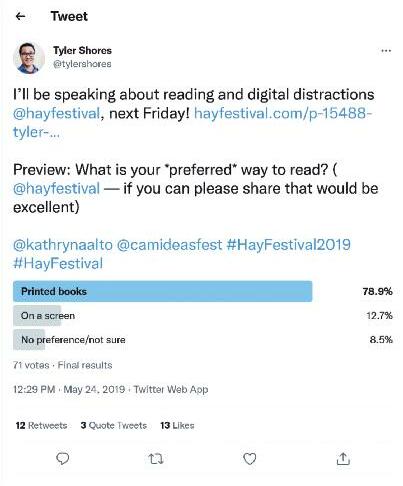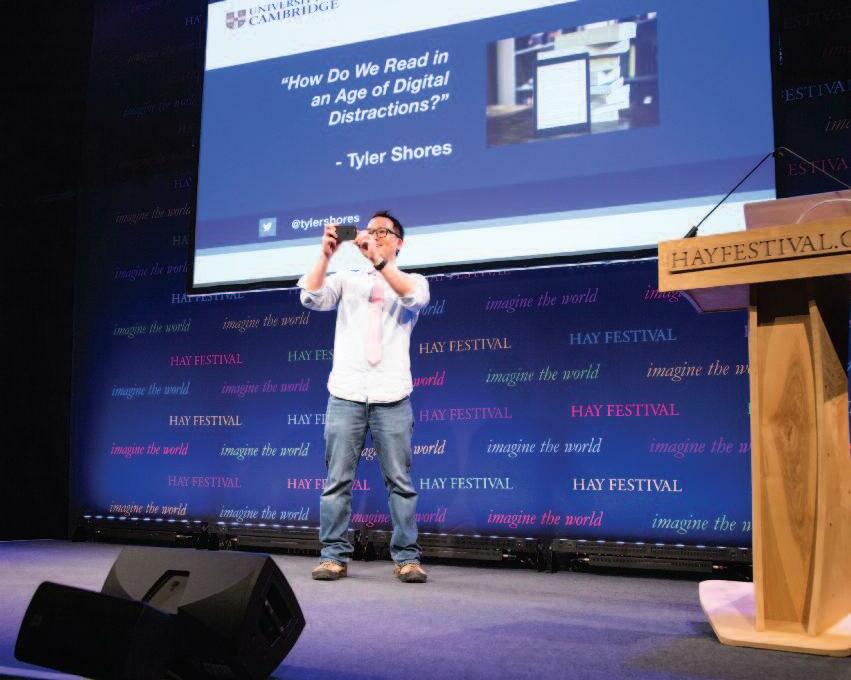
9 minute read
How does social media affect our sense of self and community? Tyler Shores
How does social media affect our sense of self and community?
Tyler Shores, Manager of the ThinkLab Program at the University of Cambridge and Senior Research Associate at the Intellectual Forum, Jesus College
Advertisement
During the pandemic, social media became our lifeline to the rest of the world. It helped us feel connected, allowed us to express ourselves and gave us the group hug we needed. Has this reliance on virtual networks affected our real-life relationships though? Now that we can meet again in person, has it changed our face-to-face interactions or our perception of community? I’ ve been researching digital distractions for the better part of a decade now, and recently my interests have focused on how social media might be changing us and making us see ourselves and others differently.
Our habits
The apps that we check throughout the day influence how and where we receive news and information, who we spend time with, what we buy, and ultimately even how we think and feel.
Think about our everyday routines and habits:
What do you think the very last thing most people do at night is, as well as the very first thing in the morning? By some estimates, about two-thirds of us use the alarm clock on our phones to wake up every morning, then spend our first waking moments scrolling through email, news, and social media. (Full disclosure, sometimes I do it, too). But the next time that you get a chance, do a mental check-in with yourself in the morning. Does the start to your day seem different if you don ’t use your phone first thing in the morning? What else do you find yourself doing instead?
Not all social media use is the same, of course. For example, one of the aspects of social media that has other researchers and myself particularly concerned is the infinite scroll, which allows users to mainline content without effort or reflection. If you ’ ve used Facebook, Instagram, Reddit, TikTok or YouTube on your mobile device then you ’ re quite familiar with how infinite scroll works and how it removes even the additional small step of needing to find a ‘ next’ button to tap or click. It’ s easy to zone out when you ’ re scrolling, but how much of the content is what we even want to see, and what longer term harm could mindless scrolling be doing to our brains and our mental health? Part of my work is looking at how we can develop healthy habits to protect ourselves mentally when absorbing content this way.
Social media and ourselves
We are social creatures who seek affirmation and belonging. That’ s why social media has become so embedded in our everyday lives. But when we step back and think about it, it can be helpful for all of us to think: what do ‘likes ’ on social media mean to us and how many are enough to satisfy us when we post online about a new baby or a new job? It’ s at least possible that our reliance on virtual affirmation through followers (oftentimes anonymous internet strangers) and ‘likes ’ reduces our need for the approval to those closest to us. Do you post online about an achievement first or call your partner or family to tell them? Most of these questions don ’t have a ‘ right’ or ‘ wrong ’ answer, but can be a good opportunity to think about how our habits have changed over the years.
And here is an even more fun thought experiment: if all of your social media profiles were to permanently disappear tomorrow, would this affect your sense of self and how would you express yourself to the world? For starters, we ’d be stumped how to register our outrage to a wide, anonymous audience. What would you miss if social media blipped out of existence? And what wouldn ’t you miss?
This is an ideal time to remind all of us that we should back up our social media accounts at least once. Sometimes our favorite photos only exist online. You can find some tips to safeguard your memories here: https://www.wired.com/2014/07/ archive-social-networks/
There are more subtle, gradual ways that social media influences how we present ourselves online. More accurately, we choose and curate what aspects of our lives we present to the world. When all we see are highlights of other people ’ s lives, our everyday offline lives can seem comparatively dull. But real life is not made of just highlights. Has anyone seen Andy Warhol’ s Empire (1965)? It’ s an eight hour film of the Empire State Building, and very little happens other than time ’ s passage. In a way, it’ s the opposite extreme of the impression of online life nowadays which is sampled in 30 and 60 second video cuts.
Social media and others
Research suggests1 that using social media does affect our interpersonal relationships. Physically, we might be right in front of a person, but our minds are somewhere else entirely. Researchers such as Sherry Turkle from the Massachusetts Institute of Technology have found that we might be less engaged in real life social interactions when a smartphone is visible – perhaps because of the ever present possibility that we can be interrupted at any time. It’ s safe to assume that in terms of quantity, we are having more conversations with more people online than ever, but we still have a finite amount of time and attention spans, so we may be trading depth of conversation for breadth.
One inevitable consequence of communicating on social media is the binary nature of how we can register our reactions. On many platforms, a ‘like ’ is our only option. (Or on Facebook, we might have the additional options of Love, Haha, Wow, Sad, and Angry). But what’ s really in a ‘like ’ , anyway? Agreement, support, or acknowledgement that we skimmed the words of a post? We can ’t help but lose some of the nuance and back and forth of real-life conversations, where issues can be discussed as having grey areas and people can be ambiguous or undecided in their opinions.
Finding and connecting with new communities and those we have shared interests with are part of the wonderful serendipity that we can experience from online platforms, yet there is a danger this can swing too far in the direction of only finding and surrounding ourselves with people very similar to ourselves.
For more information on how this might play a role in our lives, here is a
fascinating link from the Reuters Institute on filter bubbles: https://reutersinstitute. politics.ox.ac.uknews/truth-behind-filterbubbles-bursting-some-myths
Does your own experience vary? Do you find that online bubbles can be as diverse as our real-life ones, or are we simply recreating online the groups we gravitate towards every day?
Social media benefits
Social media has changed our day-to-day lives in a number of ways, including positive ones. The best way I can sum up social media ’ s benefits is that it has brought an overall increase of serendipity into most of our lives. Its inclusive nature means that conversations can be opened up to new and unexpected contacts and sources of information. Conversations and discussions aren ’t limited to what occurs in a bound, physical space but can include participants from almost anywhere and the online nature of those kind of discussions give us that extra processing time to pause and reflect. Conversations in-person happen during one point in time and in one place, but I’ m fascinated about the half-lives of conversations on social media. Sometimes we see conversations revived from months or years ago with new information and new participants.
From a teaching perspective, I often find myself using social media to share and include people from far beyond the classroom (or, Zoom room). I use social media alongside real-life events to share what’ s happening live as well as to gather audience opinion using polls and open-ended questions as a means to open up a discussion. When I spoke at the Hay Festival a few years ago, I ran a poll every day to reach out to a wider audience.
Thanks to using hashtags and tagging different accounts, it can be fascinating to see the kinds of responses and insights that are shared from a wider online audience.
Online interactions like this can bring surprises as well. One thing that strikes me is that people are often more likely to share more personal information such as their struggles with mental health or depression online as opposed to in person. Social media can be a means of creating deeper, and more meaningful connections.

Mindful browsing
So how do we enjoy the benefits of social media whilst protecting our mental health and preserving our real-life relationships? Below are some of my favourite tips; there is no one way that works for everyone so feel free to experiment. Do you have any favourite tips? Please do share on Twitter @tylershores
Tyler’s tips
Out of sight, out of mind:
If you had to guess, what percentage of the day do you spend with your phone or a digital device within arm ’ s reach? Try placing your phone in another room, or at least out of your immediate sight. Or at the very least, try having your phone screen faced down. Try it out for a week or two – does that small behavioral nudge change how often you check things online?

Tyler Shores at the Hay Festival
Less screen time at bedtime:
Can you live without your phone on your nightstand? If you use your phone as your alarm, try an actual alarm clock! Phone time right before bed gives us the double whammy of blue light exposure and (probably) checking social media and news which in turn might make it harder for us to fall asleep.
Try a social media budget:
If you use an Apple or Android device, the built-in Screen Time (iOS) and Digital Wellbeing (Android) can give us quite useful information, which can be found in your device ’ s Settings. Whatever your current numbers might be, if you wanted to tweak your social media habits, consider a social media time budget of 30 or 60 minutes allocated for whatever your favorite app might be, but make an effort to stick to that time only. Try it for a week. Does that change your online habits?
We recently hosted an event with film director Jeff Orlowski, on ‘The Social Dilemma ’ which is available to watch online now here: https://www.youtube.com/watch?v=6OwgoUbufs n
1 Przybylski, A. K., & Weinstein, N. (2013).
‘Can you connect with me now? How the presence of mobile communication technology influences face-to-face conversation quality ’ . Journal of Social and Personal Relationships 30(3), 237–246.










